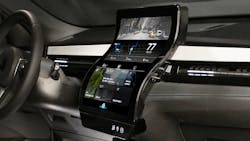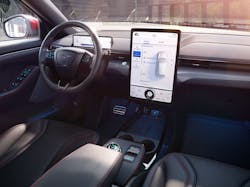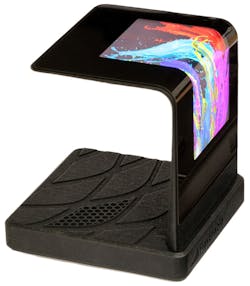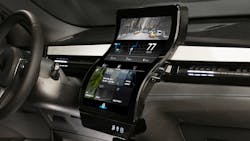Curved In-Vehicle Displays: Drivers and Challenges
This article is part of TechXchange: Advanced Display Technology
Increasing automation, safety, and connectivity features in today’s automotive interior designs are driving the rapid growth of active-matrix information displays. Traditional display applications such as the center console and the instrument panel account for part of this, but we’re starting to see new applications as well—for example, side-mirror replacement displays. This evolution of the automotive HMI is creating a need for displays that are integrated into the non-rectangular and non-flat surfaces of the car in such a way where it’s not obtrusive for the users and doesn’t compromise the car design.
Let’s look at some of the key drivers for the proliferation of in-vehicle displays:
Touchscreens
Research1 shows that users prefer touchscreens over all other forms of input. In contrast, physical buttons are generally the least popular input device. Thus, it’s no surprise that they’re fast disappearing in favor of touch displays—in particular, capacitive touchscreens will be favored as they mimic the performance offered by smartphones.
IHS Markit estimates nearly 46 million additional displays will proliferate through the cockpit of vehicle interiors from 2019 to 2025—a trend also influenced by an automaker’s realization that the technology in the vehicle’s interior can serve as a brand differentiator.2 Looking further into the future, we can imagine a car interior where a touchscreen takes the place of every existing physical button today. All aspects of the HMI would then become highly upgradable and reconfigurable, and be able to be personalized according to the “app” being used.
Larger screens
A more near-term trend in automotive displays is that the instrument panel and center-stack displays are rapidly becoming larger. IHS Markit predicts a growth hot spot in 7- to 8-in. displays for the center stack and instrument cluster, which will alone account for more than 50 million units in 2023.3 Companies like Tesla already use large displays like the 17-in. touchscreen display in its Model S, which dominates the center of the dashboard. More recently, Ford announced its Mustang Mach-E (expected to ship in early 2021), which has a 15.5-in. vertical touchscreen display (Fig. 1).
In both of those examples, the displays are a noticeable constraint to the vehicle interior. They show that it’s becoming increasingly difficult to accommodate large and flat displays in an ergonomically optimized interior design where every other surface is curved.
Displays for safety
In-vehicle displays are also increasingly being used to enhance the car safety features. These displays work in combination with multiple sensors and cameras around the car that can warn of hazards on the road. In next-generation cars, these displays will ideally need to conform naturally to the curved surfaces of the car and be unobtrusive when not displaying information. For example, curved displays can be used as “digital” side-view mirrors to increase safety by widening the field of view as well as contributing to fuel efficiency in comparison with the external side-view mirrors (Fig. 2).4
Requirements to Consider for Automotive Surface-Integrated Displays
In addition to the ability to be conformed and shaped, surface-integrated displays must meet strict automotive requirements:
Lifetime
Automotive surface-integrated displays need to last as long as the lifetime of a vehicle, which could be more than 10-15 years. This is much longer than the lifetime of many mainstream consumer electronic products such as, for example, smartphones and smartwatches, which are already using flexible displays.
Reliability
In-vehicle displays face a unique environment and therefore require high-level reliability. They have to be tested in much higher and much lower temperature and humidity conditions compared to consumer electronics.
Low cost
Apart from meeting all other requirements, for any new technology to be adopted in automotive, it must be available at an affordable price. This requirement is even more important given the trend for bigger screens.
Flexible Display Technologies
The dominant active-matrix display technology in vehicles is LCD, which is made with amorphous silicon (a-Si) thin-film transistors (TFTs) on glass. However, glass can only be curved to an extremely limited extent and is difficult to cut to non-rectangular shapes. It’s also relatively thick and heavy and can shatter, causing issues with head impact.
Flexible OLED and flexible OLCD are the two leading candidates for conformed and shaped in-vehicle displays. While they both present manufacturing challenges due to the special techniques and methods required for making the display on a flexible plastic substrate, they also open the door to many opportunities.
Flexible OLED
Flexible OLED (organic light-emitting diode) displays are made onto polyimide (plastic) substrates, making them even thinner, more conformable, and more shapeable compared to their glass counterparts. They offer great front-of-screen performance in terms of contrast, color gamut, and refresh rate.
However, flexible OLED displays are expensive to manufacture for several reasons. For one, the cost of materials and the process complexity means that yield is relatively low at present and gets even lower for larger displays. Secondly, the lifetime of OLED displays, particularly on flexible substrates, is fine for consumer electronics applications, but not yet at a point where it can be used for higher specification applications like automotive. This is because the lifetime of OLEDs is inversely proportional to the square of the pixel brightness—but applications such as automotive need both long lifetime and high brightness.
Flexible OLCD
Flexible OLCD (organic liquid-crystal display) technology builds on proven LCD technology and is a significantly lower-cost manufacturing process than flexible OLED displays (Fig. 3). The main reason for this is the lower processing temperature of OLCD, which is possible because the use of organic instead of silicon-based thin-film transistors (TFTs). These organic TFTs (OTFTs) can be processed at maximum temperature below 100°C, which removes the need for PI films (needed for silicon-based TFTs), and it allows low-cost TAC film to be used as a substrate.
Moreover, OLCD can be manufactured on existing flat-panel-display lines, reusing already available equipment and utilizing the existing supply chain. To put this in context, flexible OLCD displays can be created for just a third of the cost of flexible active-matrix OLED (AMOLED) displays, opening up the use of flexible displays to a wider range of applications.
OLCD uses a separate backlight that allows for high luminescence levels to be delivered without compromising the display lifetime; and unlike OLEDs, OLCDs aren’t prone to burn in. This means that high brightness of automotive applications can be met by using a brighter backlight (a separate light source) with no impact on display lifetime. In contrast, OLED lifetime decreases rapidly with increased brightness.
OLCD is also capable of meeting the demand for ever-increasing contrast in automotive displays. This can be achieved by using a “dual-cell” approach where a second cell is added to the display stack. TVs are starting to adopt such an approach to drastically increase the contrast of the display.
OLCD is particularly suited for the fabrication of dual cell as it’s extremely thin, providing advantages in cost, viewing angle, and module thickness, and retaining the flexibility required for automotive applications. The flexibility of OLCD also allows an ultra-narrow bezel to be implemented by folding the borders of the display.
The Future: Challenges and Opportunities
Flexible display technologies will allow car designers to design the cockpit of the car without constraints and deliver automotive HMIs of the future. Car manufacturers and Tier 1 suppliers are already experimenting with flexible display technologies. Some striking car prototypes featuring curved OLED displays were revealed earlier this year at CES 2020.5 OLCDs have also been demonstrated in a car concept created by global plastic solutions provider Novares,6 highlighting example applications of surface-integrated displays in next-generation vehicle interiors (Fig. 4). These include both convex and concave examples of OLCDs, which allow them to be seamlessly integrated into the vehicle interior.
Non-flat and non-rectangular displays present both new system design challenges and opportunities. Automotive flexible displays will typically require lamination and assembly into a shaped cover lens or “window,” which is likely to be very specific to the vehicle interior design. In many cases, the HMI features enabled by the conformed display will also require the development of additional systems and software. Overcoming these challenges and accelerating the adoption of this new generation of displays will therefore depend on a much closer and more collaborative relationship between Tier 1s, display makers, and vehicle manufacturers than typically exists today.
Dr. Paul Cain is Strategy Director at FlexEnable.
Read more articles in TechXchange: Advanced Display Technology
References
2. https://ihsmarkit.com/research-analysis/ces-2020.html
5. https://www.bbc.co.uk/news/technology-51030022
6. https://www.novaresteam.com/our-solutions/novacar-2-an-open-innovation-lab/
About the Author

Paul Cain
Strategy Director, FlexEnable
Paul Cain, strategy director at FlexEnable, has 20 years of experience in flexible and organic electronics, both in technical and strategic roles. Paul has a PhD in physics from the University of Cambridge and an MBA from London Business School.




